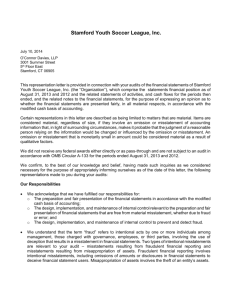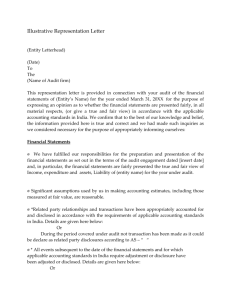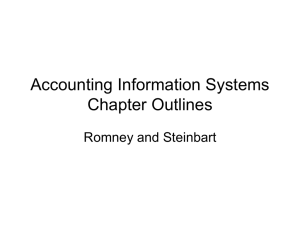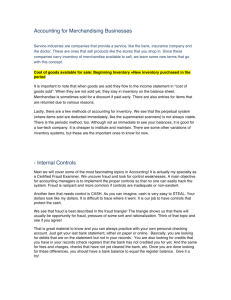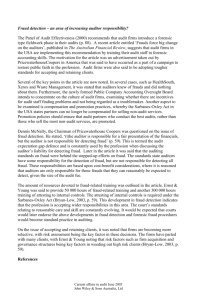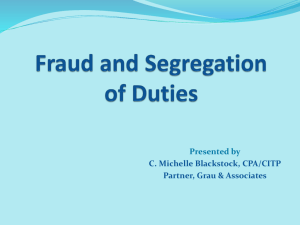Chapter 4 review
advertisement
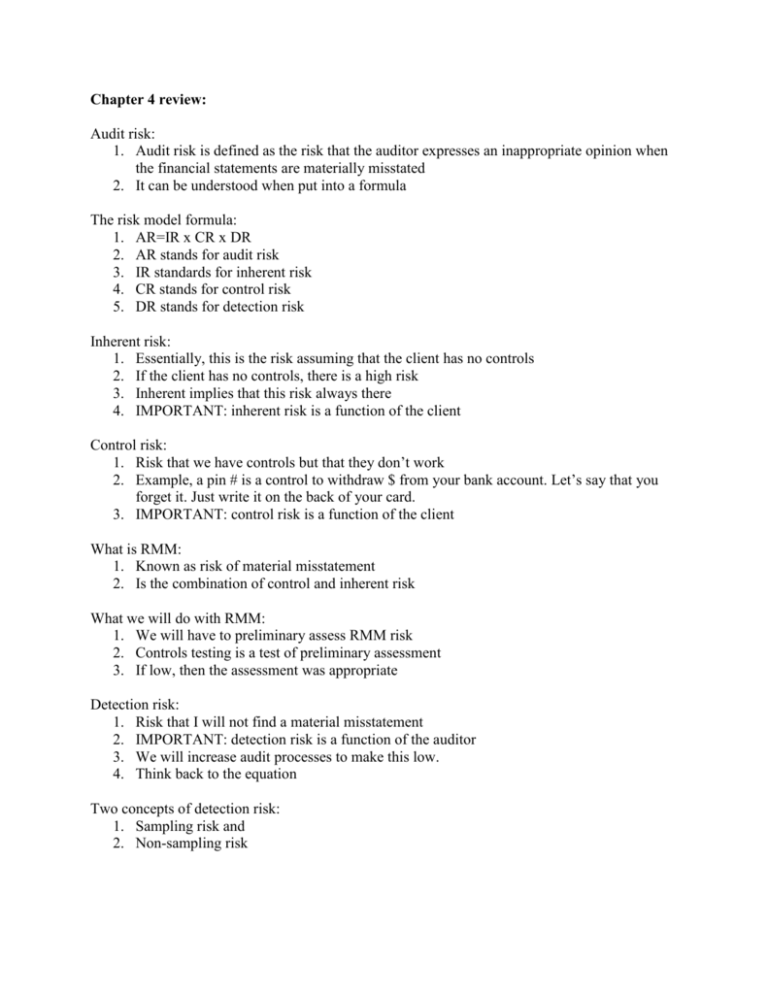
Chapter 4 review: Audit risk: 1. Audit risk is defined as the risk that the auditor expresses an inappropriate opinion when the financial statements are materially misstated 2. It can be understood when put into a formula The risk model formula: 1. AR=IR x CR x DR 2. AR stands for audit risk 3. IR standards for inherent risk 4. CR stands for control risk 5. DR stands for detection risk Inherent risk: 1. Essentially, this is the risk assuming that the client has no controls 2. If the client has no controls, there is a high risk 3. Inherent implies that this risk always there 4. IMPORTANT: inherent risk is a function of the client Control risk: 1. Risk that we have controls but that they don’t work 2. Example, a pin # is a control to withdraw $ from your bank account. Let’s say that you forget it. Just write it on the back of your card. 3. IMPORTANT: control risk is a function of the client What is RMM: 1. Known as risk of material misstatement 2. Is the combination of control and inherent risk What we will do with RMM: 1. We will have to preliminary assess RMM risk 2. Controls testing is a test of preliminary assessment 3. If low, then the assessment was appropriate Detection risk: 1. Risk that I will not find a material misstatement 2. IMPORTANT: detection risk is a function of the auditor 3. We will increase audit processes to make this low. 4. Think back to the equation Two concepts of detection risk: 1. Sampling risk and 2. Non-sampling risk Using the audit risk model: 1. Set a planned level of audit risk such that an opinion can be issued on the financial statements 2. Assess the risk of material misstatement (IR x CR) Sampling risk: 1. Cost should not exceed benefits. Don’t look at everything. 2. So sampling risk is the risk that the sample is not reflective of the whole 3. For example: ACCT vs. University, the sample is biased. Non-sampling risk: 1. This is everything except for sampling 2. Inappropriate audit procedures 3. Failure to detect when using appropriate audit procedures 4. Misinterpreting audit results Limitation to the audit risk model: 1. The desired level of audit risk may not actually be achieved 2. It does not consider potential auditor error The risk assessment 1. Auditor need to identify business risk and understand the potential misstatements that may result 2. Business risks are risks that result from significant conditions, events, circumstances or actions that impair managements’ ability to execute strategies The business acumen: business risk 1. Nature of entity 2. Industry, regulator, and external factors 3. Objectives and strategies The nature of entity 1. The entity’s organization structure and management personnel 2. The sources of funding of the entity’s capital structure, noncapital funding, and other debt instruments 3. The entity’s investments 4. The entity’s operating characteristics, including its size and complexity 5. The sources of the entity’s earning, including the relative profitable of key products and services 6. Key supplier and customer relationships Industry, regulatory, and external factors: 1. Market and competition, including demand, capacity, and price competition 2. Cyclical or seasonal activity 3. Product technology relating to the entity’s products 4. Supply availability and cost 5. Accounting principles and industry specific practices 6. Regulatory framework for a regulated industry 7. Legislation that significantly affect the entity’s operations 8. Environmental requirements 9. General level of economic activity 10. Interest rates and availability of financing Objectives and strategies 1. Industry developments 2. New products and services 3. Expansion of the business 4. New accounting requirements 5. Entity performance measure (preliminary analytics) 6. Internal controls Preliminary analytic examples: 1. Know the changes from account balances and ratios between period. Assessing the risk of material misstatement due to fraud Examples of misstatements: 1. Inaccuracy in gather or processing data from which financial statements are prepared 2. A difference between the amount of a reported financial statement account and the amount that would have been reported under GAAP 3. The omission of a financial statement element, account, or item 4. An incorrect accounting estimate arising from an oversight or misinterpretation of facts There are two types of errors: 1. Errors and fraud 2. Error are unintentional misstatements 3. Fraud involves intentional misstatements Fraud triangle: 1. Incentive or pressure to perpetrate fraud 2. Opportunity to carry out fraud 3. Attitude or rationalization to justify fraud Incentive or pressure to perpetrate fraud: 1. Excessive pressure to meet third party expectations 2. Financial stability or profitability is threatened 3. Management’s personal financial situation is threatened Opportunity to carry out fraud 1. Nature of the industry or entity’s operations 2. Complex or unstable organizational structure 3. Ineffective monitoring of management 4. Deficient internal control Attitude or rationalization to justify fraud:APCW 1. Use of inappropriate accounting based on materiality 2. Poor communication channels for reporting inappropriate behavior 3. Committing to aggressive or unrealistic forecasts 4. Weak ethical standards for management behavior Two types of intentional misstatements 1. Fraudulent financial reporting 2. Misappropriation of assets Fraudulent financial reporting: 1. Manipulation of accounts records of supporting documents used to prepare financial statements 2. Misrepresentation or intentional omission from the financial statements of events, transactions, or significant information 3. Intentional misapplication of accounting principles relating to amount, classification, manner of presentation, or disclosure Misappropriation of assets 1. Involves the theft of an entity’s assets to the extent that financial statements are misstated Response to the risk of fraud: 1. Emphasize the need to maintain professional skepticism 2. Assign more experienced staff or those with specialized skills 3. Provide more supervision 4. Incorporate additional elements of unpredictability in the selection of audit procedures Evaluation of test results If the misstatement is or may be the result of fraud, and the effect could be material: 1. Obtain evidence whether, in fact, material fraud has occurred and its effect 2. Consider implications for other aspects of the audit 3. Discuss the matter and the approach to further investigation with an appropriate level of management that is at least one level above those involved in committing the fraud and with senior management 4. If appropriate, suggest that the client consult with legal counsel 5. Consider withdrawing from the engagement Documentation requirements 1. Discussions among engagement personnel 2. Procedures performed to identify and assess the risk of material misstatement due to fraud 3. Risk of identified material misstatement due to fraud and a description of the auditor’s response to the risks 4. Fraud risks or other conditions that result in additional audit procedures 5. The nature of the communications about fraud made to management, the audit committee, and others. Communications about fraud 1. Only when required as a result of regulatory requirements 2. To a successor auditor 3. In response to a subpoena 4. To a funding agency that provides governmental financial assistance 4-13: 1. Materiality and audit risk (D) 4-14: 1. (A) Audit risk is the risk that the auditor gives an inappropriate opinion regarding financial statements 4-15: 1. (C) Basic definition 4-16: 1. Find smaller errors (A). Inverse relationship between materiality and sampling 4-17: 1. (C) policy that the precedessor auditor discloses everything 4-18: 1. (C) because the managers can be influenced to cheat 4-19: 1. (C) theft is clearly misappropriation of assets. 4-20 1. B. Need to ask. Helps with planning 4-21: 1. (A) Misstating a material component for the financial statements. Lying 4-22: 1. (A) Need to tell the audit committee what is going on
